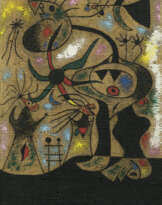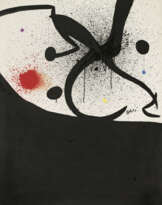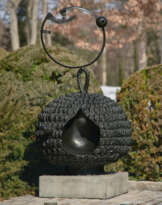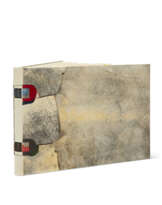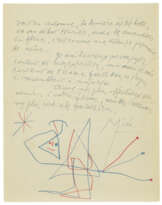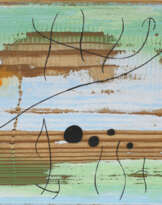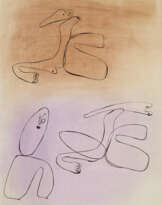ID 846167
Lot 675 | JOAN MIRÓ (1893-1983)
Valeur estimée
$ 100 000 – 150 000
Sans titre
signed and dated 'Joan Miró. 15/2/34.’ (on the reverse)
watercolor, pastel and brush and India ink on paper
25 1/8 x 18 3/8 in. (63.9 x 46.7 cm.)
Executed on 15 February 1934
Provenance
Galerie Gerald Cramer, Geneva (1959).
Blanche and Harry Sundheim, Jr., Chicago; sale, Sotheby Parke Bernet, Inc., New York, 6 December 1972, lot 30.
Anon. sale, Sotheby Parke Bernet, Inc., New York, 17 May 1979, lot 477.
Waddington Galleries, Ltd., London.
Acquired from the above by the late owner, November 1979.
Literature
J. Dupin and A. Lelong-Mainaud, Joan Miró: Catalogue Raisonné, Drawings, 1901-1937, Paris, 2008, vol. I, p. 200, no. 411 (illustrated in color, p. 201).
Exhibited
Barcelona, Fundació Joan Miró and London, Whitechapel Gallery, Joan Miró: Paintings and Drawings, 1929-1941, November 1988-April 1989 (illustrated in color; titled Three Figures).
Post lot text
Executed in 1934, during one of the most creative and interesting periods of Miró’s artistic career, Sans Titre is a testament to the artist’s ability to convey playfulness and movement through simple yet incredibly expressive means. The mid 1930s were a time of great innovation for the artist, marked by his rupture with the Surrealists and a newfound political interest. By 1929, Miro had officially distanced himself from André Breton and the Surrealist group, of which he had been such an integral part since its onset. Adamant on moving beyond the confines of any established artistic movement and of any ‘isms’, Miró began searching for his own new way forward. His answer lay in his overt willingness to, in his own words, ‘assassinate painting’, and upset the visual elements of traditional and established art by disrupting his compositions through the inclusion of unexpected subjects or the use of unconventional mediums.
It is no surprise that the present work was produced only a few months before the beginning of the artist’s so-called ‘wild period’, when, after visiting his native Spain, the artist encountered heightened political tensions and instability provoked by the increasingly extremist stance of both right-wing and left-wing political forces in the country. Miro’s 1930s works seem to be in tangible dialogue with political events of the interwar years, especially those affecting his home country. His subject matter in this phase is to be understood vastly as a reflection of this exasperated political situation: he started populating his works with monstrous shapes that confront the viewer head on, not dissimilar to the ones levitating in the present work.
It is within the context of this political turmoil and the artist’s post-Surrealist manifesto that the present work should be understood: here, one can truly witness the artist come to terms with his new artistic agenda. The sheet shows three distinct figures made up of curvilinear anthropomorphic forms, each standing against a delicately colored background of blush red and pastel purple hues. The interplay of this soft palette and these round organic shapes is used to achieve a visual sense of dynamism and upheaval that is profoundly intrinsic to the artist’s aesthetic of the early 1930s. With approximately ten whimsical shapes, the artist is able to render a contagious feeling of unexpected playfulness, his own personal way to ‘assassinate painting’.
| Artiste: | Joan Miró (1893 - 1983) |
|---|---|
| Style artistique: | Art moderne |
| Artiste: | Joan Miró (1893 - 1983) |
|---|---|
| Style artistique: | Art moderne |
| Adresse de l'enchère |
CHRISTIE'S 20 Rockefeller Plaza 10020 New York Etats-Unis | ||||||||||||||
|---|---|---|---|---|---|---|---|---|---|---|---|---|---|---|---|
| Aperçu |
| ||||||||||||||
| Téléphone | +1 212 636 2000 | ||||||||||||||
| Fax | +1 212 636 4930 | ||||||||||||||
| Conditions d'utilisation | Conditions d'utilisation | ||||||||||||||
| transport |
Service postal Service de messagerie ramassage par vous-même | ||||||||||||||
| Modes de paiement |
Virement bancaire | ||||||||||||||
| Heures d'ouverture | Heures d'ouverture
|




